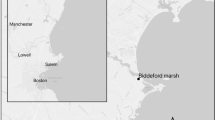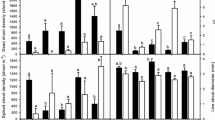Abstract
We explored to what extent morphological variation and habitat modification are correlated for an autogenic ecosystem engineer, which is an organism that modifies its habitat via its own physical structures. The intertidal salt marsh speciesSpartina anglica is well known for its capacity to enhance sediment accretion within its canopy by reducing hydrodynamic energy. Sediment accretion is favorable toSpartina, as it reduces inundation stress, enhances soil drainage, and enhances nutrient availability. Shoot density and clonal architecture showed a large variation that was strongly correlated with the marsh elevation and sediment type. This correlation showed that at the lowest elevations at the muddy site,Spartina tussocks had the highest shoot density, which is known to be favorable for sediment accretion by reduction of hydrodynamic energy. There was also a strong positive correlation between the amount of sediment that accumulated within a tussock and gully formation around thatSpartina tussock. The tussocks at the lowest elevations at the muddy site had the lowest lateral tussock growth. At the highest elevations at the sandy site, stem densities were lower and there was a relatively high rate of clonal expansion and marsh formation. At this location, we also observed tussock mortality due to erosion of several of these openly structured tussocks. Based on the observed correlations, we hypothesize that the morphology ofSpartina represents trade-offs between the capacity to maximize habitat modification through sediment trapping by having a high shoot density versus the capacity to maximize clonal expansion by spreading shoots widely and the capacity of maximal clonal expansion by spreading shoots widely versus the risk of tussock mortality due to insufficient modification of the habitat that makes the tussock vulnerable to erosion. Our results indicated that morphological variation and habitat modification are strongly correlated for the autogenic ecosystem engineerS. anglica.
Similar content being viewed by others
Literature Cited
Adam, P. 1990. Saltmarsh Ecology, Cambridge University Press, Cambridge, Massachusetts.
Allen, J. R. L. 2000. Morphodynamics of Holocene salt marshes: A review sketch from the Atlantic and southern North Sea coasts of Europe.Quaternary Science Reviews. 19:1155–1231.
Anderson, C. M. andM. Treshow. 1980. A review of environmental and genetic factors that affect height inSpartina alterniflora Loisel. (salt marsh cord grass).Estuaries 3:168–176.
Arenovski, A. L. andB. L. Howes. 1992. Lacunal allocation and gas transport capacity in the salt marsh grassSpartina alterniflora.Oecologia 90:316–322.
Bertness, M. D. andR. Callaway. 1994. Positive interactions in communities.Trends in Ecology and Evolution 9:191–193.
Bouma, T. J., M. B. De Vries, E. Low, L. Kusters, P. M. J. Herman, I. C. Tánczos, S. Temmerman, A. Hesselink, P. Meire, andS. Van Regenmortel. 2005a. Flow hydrodynamics on a mudflat and in salt marsh vegetation: Identifying general relationships for habitat characterizations.Hydrobiologia 540:259–274.
Bouma, T. J., M. B. De Vries, E. Low, G. Peralta, I. C. Tánczos, J. Van de Koppel, andP. M. J. Herman. 2005b. Trade-offs related to ecosystem-engineering: A case study on stiffness of emerging macrophytes.Ecology 86:2187–2199.
Bouma, T. J., B. P. Koutstaal, M. Van Dongen, andK. L. Nielsen. 2001. Coping with low nutrient availability and inundation: Root growth responses of three halophytic grass species from different elevations along a flooding gradient.Oecologia 126: 472–481.
Bouma, T. J., J. Stapel, J. van der Heiden, B. Koutstaal, J. van Soelen, andL. van Ijzerloo. 2002. Relative importance of macrophyte leaves for nitrogen uptake from flood water in tidal salt marshes.Marine Ecology-Progress Series 240:93–104.
Bouma, T. J., L. A. Van Duren, S. Temmerman, T. Claverie, A. Blanco-Garcia, T. Ysebaert, and P. M. J. Herman. 2007. Spatial sedimentation patterns within patches of epibenthic structures: Combining field, flume and modelling experiments.Continental Shelf Research in press.
Bradley, P. M. andJ. T. Morris. 1990. Influence of oxygen and sulfide concentration on nitrogen uptake kinetics inSpartina alterniflora.Ecology 71:282–287.
Bruno, J. F.. 2000. Facilitation of cobble beach plant communities through habitat modification bySpartina alterniflora.Ecology 81: 1179–1192.
Bruno, J. F. andC. W. Kennedy. 2000. Patch-size dependent habitat modification and facilitation on New England cobble beaches bySpartina alterniflora.Oecologia 122:98–108.
Castellanos, E. M., M. E. Figueroa, andA. J. Davy. 1994. Nucleation and facilitation in saltmarsh succession: Interactions betweenSpartina maritima andArthrocnemum perenne.Journal of Ecology 82:239–248.
Castilia, J. C., N. A. Lagos, andM. Cerda. 2004. Marine ecosystem engineering by the alien ascidianPyura praeputialis on a mid-intertidal rocky shore.Marine Ecology-Progress Series 268: 119–130.
Crooks, J. A.. 2002. Characterizing ecosystem-level consequences of biological invasions: The role of ecosystem engineers.Oikos 97:153–166.
Dawkins, R. 1982. The Extended Phenotype: The Long Reach of the Gene. Oxford University Press, Oxford, New York.
Dawkins, R. 2004. Extended Phenotype—But Not Too Extended. A Reply to Laland, Turner and Jablonka.Biology and Philosophy 19:377–396.
Day, R. L., K. N. Laland, andJ. Odling-Smee. 2003. Rethinking adaptation: The niche-construction perspective.Perspectives in Biology and Medicine 46:80–95.
Defew, E. C., T. J. Tolhurst, andD. M. Paterson. 2002. Sitespecific features influence sediment stability of intertidal flats.Hydrology and Earth System Sciences 6:971–982.
Gleason, M. L., D. A. Elmer, N. C. Pien, andJ. S. Fischer. 1979. Effects of stem density upon sediment retention by salt marsh cord grass,Spartina alterniflora Loisl.Estuaries 2:271–273.
Gould, S. G. andE. Vrba. 1982. Exaptation—a missing term in the science of form.Paleobiology 8:4–15.
Grime, J. P.. 1977. Evidence for the existence of three primary strategies in plants and its relevance to ecological and evolutionary theory.American Naturalist 111:1169–1194.
Grime, J. P.. 1988. Critique of the triangular model of primary plant strategies-comment.Ecology 69:1618–1620.
Grime, J. P. andJ. M. L. Mackey. 2002. The role of plasticity in resource capture by plants.Evolutionary Ecology 16:299–307.
Hacker, S. D. andM. D. Bertness. 1999. Experimental evidence for factors maintaining plant species diversity in a New England salt marsh.Ecology 80:2064–2073.
Hacker, S. D., D. Heimer, C. E. Hellquist, T. G. Reeder, B. Reeves, T. J. Riordan, andM. N. Dethier. 2001. A marine plant (Spartina anglica) invades widely varying habitats: Potential mechanisms of invasion and control.Biological Invasions 3:211–217.
Harley, C. D. G. andM. D. Bertness. 1996. Structural interdependence: An ecological consequence of morphological responses to crowding in marsh plants.Functional Ecology 10: 654–661.
Hemminga, M. A., J. Vansoelen, andY. E. M. Maas. 1998. Biomass production in pioneerSpartina anglica patches: Evidence for the importance of seston particle deposition.Estuarine Coastal and Shelf Science 47:797–805.
Herman, P. M. J., J. J. Middelburg, andC. H. R. Heip. 2001. Benthic community structure and sediment processes on an intertidal flat: Results from the ECOFLAT project.Continental Shelf Research 21:2055–2071.
Holmer, M., B. Gribsholt, andE. Kristensen. 2002. Effects of sea level rise on growth ofSpartina anglica and oxygen dynamics in rhizosphere and salt marsh sediments.Marine Ecology-Progress Series 225:197–204.
Hutchings, M. J. 1979. Weight-density relationships in ramet populations of clonal perennial herbs, with special reference to the −3/2 power law.Journal of Ecology 67:21–33.
Jones, C. G., J. H. Lawton, andM. Shachak. 1994. Organisms as ecosystem engineers.Oikos 69:373–386.
Jones, C. G., J. H. Lawton, andM. Shachak. 1997. Positive and negative effects of organisms as physical ecosystem engineers.Ecology 78:1946–1957.
Leonard, L. A. andM. E. Luther. 1995. Flow hydrodynamics in tidal marsh canopies.Limnology and Oceanography 40:1474–1484.
Leonard, L. A., P. A. Wren, andR. L. Beavers. 2002. Flow dynamics and sedimentation inSpartina alterniflora andPhragmites australis marshes of the Chesapeake Bay.Wetlands 22:415–424.
Mendelssohn, I. A. andJ. T. Morris. 2000. Eco-physiological controls on the productivity ofSpartina alterniflora Loisl., p. 59–80.In M. Weinstein and D. Kreeger (eds.), Concepts and Controversies in Salt Marsh Ecology. Kluwer Academic Publishers, Dordrecht, Holland.
Miller, W. D., S. C. Neubauer, andI. C. Anderson. 2001. Effects of sea level induced disturbances on high salt marsh metabolism.Estuaries 24:357–367.
Nepf, H. M. 1999. Drag, turbulence, and diffusion in flow through emergent vegetation.Water Resources Research 35:479–489.
Neumeier, U. andP. Ciavola. 2004. Flow resistance and associated sedimentary processes in aSpartina maritima salt-marsh.Journal of Coastal Research 20:435–437.
Nieva, F. J. J., E. M. Castellanos, J. M. Castillo, andM. E. Figueroa. 2005. Clonal growth and tiller demography of the invader cordgrassSpartina densiflora Brongh. at two contrasting habitats in SW European salt marshes.Wetlands 25:122–129.
Niklas, K. J. 1992. Plant Biomechanics: An Engineering Approach to Plant Form and Function. University of Chicago Press, Chicago, Illinois.
Odling-Smee, J., K. N. Laland, andM. W. Feldman 2003. Niche Construction; The Neglected Process in Evolution. Princeton University Press, Princeton, New Jersey.
Ornes, W. H. andD. I. Kaplan. 1989. Macronutrient status of tall and short forms ofSpartina alterniflora in a South Carolina salt marsh.Marine Ecology-Progress Series 55:63–72.
Pezeshki, S. R. andR. D. Delaune. 1993. Effects of soil hypoxia and salinity on gas exchange and growth ofSpartina patens.Marine Ecology-Progress Series 96:75–81.
Ranwell, D. S. 1967. World resources ofSpartina townsendii (sensu lato) and economic use ofSpartina marshland.Journal of Applied Ecology 4:239–256.
Redfield, A. 1972. Development of a New England salt marsh.Ecological Monographs 42:201–237.
Sanchez, J. M., D. G. Sanleon, andJ. Izco. 2001. Primary colonization of mudflat estuaries bySpartina maritima (Curtis) Fernald in northwest Spain: Vegetation structure and sediment accretion.Aquatic Botany 69:15–25.
Seneca, E. D. andU. Blum. 1984. Response to photoperiod and temperature bySpartina alterniflora (Poaceae) from North Carolina andSpartina foliosa from California.American Journal of Botany 71:91–99.
Silliman, B. R. andJ. C. Zieman. 2001. Top-down control ofSpartina alterniflora production by periwinkle grazing in a Virginia salt marsh.Ecology 82:2830–2845.
Soetaert, K., J. J. Middelburg, C. Heip, P. Meire, S. Van Damme, andT. Maris. 2006. Long-term change in dissolved inorganic nutrients in the heterotrophic Scheldt estuary (Belgium, The Netherlands).Limnology and Oceanography 51:409–423.
Stearns, S. C. 1989. Trade-offs in life-history evolution.Functional Ecology 3:259–268.
Temmerman, S., G. Govers, S. Wartel, andP. Meire. 2003. Spatial and temporal factors controlling short-term sedimentation in a salt and freshwater tidal marsh, Scheldt estuary, Belgium, SW Netherlands.Earth Surface Processes and Landforms 28:739–755.
Tilman, D. 1988. Plant Strategies and the Dynamics and Structure of Plant Communities. Princeton University Press, Princeton, New Jersey.
Van de Koppel, J., D. Van der Wal, J. P. Bakker, andP. M. J. Herman. 2005. Self-organization and vegetation collapse in salt marsh ecosystems.American Naturalist 165:E1-E12.
Widdows, J. andM. Brinsley. 2002. Impact of biotic and abiotic processes on sediment dynamics and the consequences to the structure and functioning of the intertidal zone.Journal of Sea Research 48:143–156.
Wright, J. P. andC. G. Jones. 2006. The concept of organisms as ecosystem engineers ten years on: Progress, limitations, and challenges.Bioscience 56:203–209.
Wright, J. P., C. G. Jones, andA. S. Flecker. 2002. An ecosystem engineer, the beaver, increases species richness at the landscape scale.Oecologia 132:96–101.
Author information
Authors and Affiliations
Corresponding author
Rights and permissions
About this article
Cite this article
van Hulzen, J.B., van Soelen, J. & Bouma, T.J. Morphological variation and habitat modification are strongly correlated for the autogenic ecosystem engineerSpartina anglica (common cordgrass). Estuaries and Coasts: J ERF 30, 3–11 (2007). https://doi.org/10.1007/BF02782962
Received:
Revised:
Accepted:
Issue Date:
DOI: https://doi.org/10.1007/BF02782962




